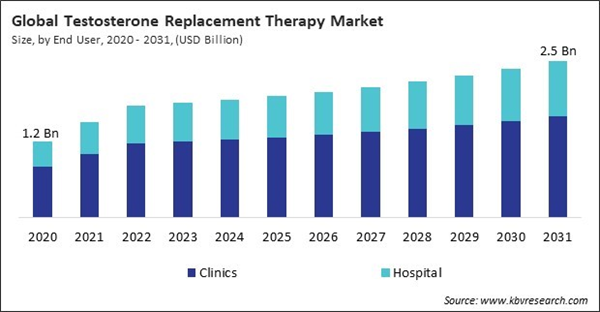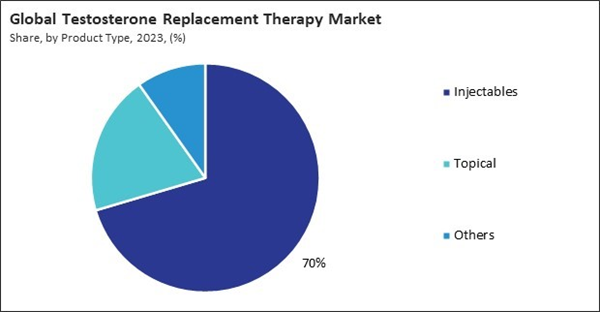The Global Testosterone Replacement Therapy Market size is expected to reach $2.5 billion by 2031, rising at a market growth of 4.1% CAGR during the forecast period.
Testosterone enanthate has been widely used and studied for TRT, demonstrating consistent effectiveness in restoring testosterone levels to within the normal physiological range and improving symptoms of hypogonadism. Consequently, the testosterone enanthate segment would generate approximately 19.3% revenue share of the market by 2031. Clinical trials and real-world experience have shown that testosterone enanthate therapy effectively improves libido, erectile function, muscle mass, bone density, mood, energy levels, and overall quality of life in individuals with testosterone deficiency.
Men’s testosterone levels naturally decrease with age, this condition is referred to as andropause or late-onset hypogonadism. Usually starting around the age of 30, this deterioration steadily gets worse over time. By the age of 40 or 50, many men may experience symptoms of low testosterone, such as reduced libido, fatigue, decreased muscle mass, and mood changes. Thus, the growing elderly population worldwide is driving the growth of the market.
Additionally, as healthcare expenditure rises, more individuals gain access to healthcare services, including preventive care, diagnostic testing, and specialized treatments. This expanded access enables more men to seek medical advice and treatment for conditions such as hypogonadism, leading to increased demand for TRT. With greater healthcare spending, there is increased investment in diagnostic technologies, screening programs, and healthcare infrastructure. In conclusion, the rising expenditure in the healthcare sector is driving the growth of the market.
However, TRT can be expensive, particularly for long-term treatment. The cost of TRT includes not only the price of testosterone medications but also expenses related to doctor visits, laboratory tests, monitoring, and follow-up appointments. The substantial expense of TRT may present a major obstacle to access for those lacking sufficient health insurance or financial means, restricting their capacity to begin or continue therapy. In conclusion, the high cost of testosterone replacement therapy is hindering the growth of the market.
The market relies on a complex global supply chain for raw materials, manufacturing, and distribution. Disruptions in the supply chain, including factory closures, transportation restrictions, and labor shortages, led to delays in product manufacturing and shortages of TRT medications in some regions. Thus, the COVID-19 pandemic had a negative impact on the growth of the market.
Testosterone enanthate has been widely used and studied for TRT, demonstrating consistent effectiveness in restoring testosterone levels to within the normal physiological range and improving symptoms of hypogonadism. Consequently, the testosterone enanthate segment would generate approximately 19.3% revenue share of the market by 2031. Clinical trials and real-world experience have shown that testosterone enanthate therapy effectively improves libido, erectile function, muscle mass, bone density, mood, energy levels, and overall quality of life in individuals with testosterone deficiency.
Men’s testosterone levels naturally decrease with age, this condition is referred to as andropause or late-onset hypogonadism. Usually starting around the age of 30, this deterioration steadily gets worse over time. By the age of 40 or 50, many men may experience symptoms of low testosterone, such as reduced libido, fatigue, decreased muscle mass, and mood changes. Thus, the growing elderly population worldwide is driving the growth of the market.
Additionally, as healthcare expenditure rises, more individuals gain access to healthcare services, including preventive care, diagnostic testing, and specialized treatments. This expanded access enables more men to seek medical advice and treatment for conditions such as hypogonadism, leading to increased demand for TRT. With greater healthcare spending, there is increased investment in diagnostic technologies, screening programs, and healthcare infrastructure. In conclusion, the rising expenditure in the healthcare sector is driving the growth of the market.
However, TRT can be expensive, particularly for long-term treatment. The cost of TRT includes not only the price of testosterone medications but also expenses related to doctor visits, laboratory tests, monitoring, and follow-up appointments. The substantial expense of TRT may present a major obstacle to access for those lacking sufficient health insurance or financial means, restricting their capacity to begin or continue therapy. In conclusion, the high cost of testosterone replacement therapy is hindering the growth of the market.
The market relies on a complex global supply chain for raw materials, manufacturing, and distribution. Disruptions in the supply chain, including factory closures, transportation restrictions, and labor shortages, led to delays in product manufacturing and shortages of TRT medications in some regions. Thus, the COVID-19 pandemic had a negative impact on the growth of the market.
By End User Analysis
By end user, the market is divided into hospital and clinics. The clinics segment attained 66.6% revenue share in the market in 2023. Clinics offer convenient access to healthcare services for individuals seeking diagnosis and treatment for hormone-related conditions such as hypogonadism. Also, clinics are often located in community settings and urban areas, making them easily accessible to patients who may not have access to hospital-based care.By Product Type Analysis
Based on product type, the market is divided into injectables, topical, and others. The topical segment attained a 19.7% revenue share in the market in 2023. Topical testosterone formulations, such as gels and creams, offer patients more convenience and ease of use than injectable or implantable options. They are typically applied to the skin once daily, allowing for self-administration at home without the need for healthcare provider visits or invasive procedures. This convenience appeals to patients seeking a noninvasive and discreet treatment option for hypogonadism.By Active Ingredient Analysis
On the basis of active ingredients, the market is segmented into testosterone undecanoate, testosterone cypionate, testosterone, testosterone enanthate, and others. The testosterone cypionate segment recorded 32.65% revenue share in the market in 2023. Testosterone cypionate has a longer half-life and a slower rate of release since it is a long-acting ester of testosterone. This characteristic allows for less frequent dosing, typically every one to two weeks, making it convenient for patients and reducing the burden of frequent injections.By Regional Analysis
Region-wise, the market is analyzed across North America, Europe, Asia Pacific, and LAMEA. The Europe region generated a 29.18% revenue share in the market in 2023. There is a growing awareness of hypogonadism and testosterone deficiency among healthcare providers and patients in Europe. Healthcare professionals are increasingly proactive in screening for and diagnosing testosterone deficiency, leading to earlier detection and treatment initiation. Additionally, educational campaigns and increased access to information contribute to heightened awareness and demand for TRT among patients.Recent Strategies Deployed in the Market
- Sep-2023: Besins Healthcare Monaco S.A.M. expanded its footprints by inaugurating a novel hormone production facility in Muel, situated near Zaragoza, Spain. Through this expansion, Besins Healthcare strengthened its commitment to expand its production capacity in Europe, boosting it by 30%. Additionally, with expansion, the company aims to meet the demand for hormonal replacement therapies (HRT).
- Sep-2022: Marius Pharmaceuticals LLC received approval from the U.S. Food and Drug Administration (FDA) for KYZATREX, an oral testosterone replacement therapy. KYZATREX is used for the treatment of conditions associated with a deficiency or absence of endogenous testosterone in adult males. Additionally, KYZATREX is approved for use in three dosage strengths: 100mg, 150mg, and 200mg.
- Mar-2022: Pfizer, Inc. completed the acquisition of Arena Pharmaceuticals, Inc., an American biopharmaceutical company. Through this acquisition, Pfizer gained access to Arena's suite of various treatment candidates developed for gastroenterology, dermatology, and cardiology areas. Additionally, Pfizer received rights to Arena’s oral, selective sphingosine 1-phosphate (S1P) receptor modulator, etrasimod, developed for a variety of immuno-inflammatory ailments.
- Feb-2022: Eli Lilly and Company signed a clinical trial collaboration and supply agreement with Veru Inc., an oncology biopharmaceutical company. Under this collaboration, the companies would evaluate the efficacy and safety of enobosarm, Veru’s oral, chemical entity, selective androgen receptor targeting agonist that activates the androgen receptor (AR), a tumor suppressor, in combination with Lilly’s Verzenio (abemaciclib), a CDK4/6 inhibitor, as a second-line therapy in the treatment of AR+ER+HER2-metastatic breast cancer.
List of Key Companies Profiled
- Endo International PLC
- AbbVie, Inc.
- Pfizer, Inc.
- Eli Lilly And Company
- Teva Pharmaceutical Industries Ltd.
- Amneal Pharmaceuticals, Inc.
- Ferring Holdings SA
- Marius Pharmaceuticals LLC
- Besins Healthcare Monaco S.A.M.
- Acrux Limited
Market Report Segmentation
By End User- Clinics
- Hospital
- Injectables
- Topical
- Others
- Testosterone Cypionate
- Testosterone Undecanoate
- Testosterone Enanthate
- Testosterone
- Others
- North America
- US
- Canada
- Mexico
- Rest of North America
- Europe
- Germany
- UK
- France
- Russia
- Spain
- Italy
- Rest of Europe
- Asia Pacific
- China
- Japan
- India
- South Korea
- Australia
- Malaysia
- Rest of Asia Pacific
- LAMEA
- Brazil
- Argentina
- UAE
- Saudi Arabia
- South Africa
- Nigeria
- Rest of LAMEA
Table of Contents
Chapter 1. Market Scope & Methodology
Chapter 2. Market at a Glance
Chapter 3. Market Overview
Chapter 4. Global Testosterone Replacement Therapy Market by End User
Chapter 5. Global Testosterone Replacement Therapy Market by Product Type
Chapter 6. Global Testosterone Replacement Therapy Market by Active ingredients
Chapter 7. Global Testosterone Replacement Therapy Market by Region
Chapter 8. Company Profiles
Companies Mentioned
- Endo International PLC
- AbbVie, Inc.
- Pfizer, Inc.
- Eli Lilly And Company
- Teva Pharmaceutical Industries Ltd.
- Amneal Pharmaceuticals, Inc.
- Ferring Holdings SA
- Marius Pharmaceuticals LLC
- Besins Healthcare Monaco S.A.M.
- Acrux Limited
Methodology

LOADING...










